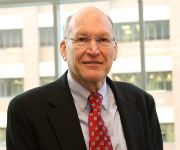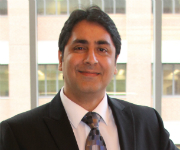contact
Megan Blackwell
Program Administrative Specialist
F 410-706-4031
The Pediatric Dentistry Post-Doctoral Program – The First 50 Years
The Beginning

The University of Maryland School of Dentistry (UMSOD) is the first dental college in the world. It was founded in 1840 as the Baltimore College of Dental Surgery (BCDS), which was chartered by the General Assembly of Maryland. Eventually, in 1923, the BCDS and the Dental Department of the University of Maryland were combined to create a distinct college of the university under state supervision and control.
The Pedodontic (as it was called then) post-graduate program was conceived in 1968, as the first specialty program offered at the Baltimore College of Dental Surgery. There was another residency program at that time, Oral Surgery, but it was a University of Maryland Hospital program. Pedodontics was followed, in the next few years, by Orthodontics, Periodontics, Endodontics, Oral Pathology, and Prosthodontics.
Chairman Donald Forrester, Assistant Professor Mark Wagner, and Dean John Salley, embarked on a project to establish a two-year post-graduate program in Pedodontics. The didactic and teaching component was to be at the dental school and the clinical and hospital training would occur at the Children’s Hospital on Greenspring Avenue. The hospital dental director was Dr. Burton R. Pollack, (Chairman of the Department of Community Dentistry) and he was to supervise and administer activities at the Children’s hospital clinic, and faculty from the dental school was to supervise operating room cases and clinical activities at the Pedo clinic in the dental school. The ADA approval came in 1969 and the first two residents enrolled, Drs. Jack Moore and Richard Thill. Dr. Wagner assumed the overall direction of the program for the first year. With the support of the dean, Dr. James Fleming was recruited, and he assumed the direction of the post-grad program, beginning with the move to the new dental school in the fall of 1970. During this time the department of Pedodontics part-time faculty consisted of Drs. Frank Kihn, Albert Zanner, Larry Fox, Ben Crosby, Gerry Weinstein, Allan Dworkin, Jerome Cullen, and Sophia Balis.
With the move to the new (now demolished) school at 666 West Baltimore Street, there was a permanent Postgraduate clinic. The off-site venues included the John F. Kennedy, Institute on the Johns Hopkins Medical Center campus, the Maryland School for the Blind, and Kernan Hospital.
The Era of Chair Dr. Donald Forrester, 1967-1977
Don (as everyone called him) was a “character”, an iconoclast, and a larger-than-life figure. He believed that post-doctoral traditional education in dental schools was insufficient and sent his pediatric students on rotations, such as: The Johns Hopkins Hospital for anesthesia, the Medical College of Virginia for head and neck anatomy, and Lancaster Cleft Palate Clinic for patients with craniofacial needs. Don was known for humanity and empathy at a time when there was little in dental education. As a result of his warmth and understanding, he became a role model for dental students and residents. These empathetic traits have become the hallmark of Pediatric Dentistry at Maryland and have continued to this day.
During Don’s years as Chair, there were over 30 dental students that, after graduation, went on to advanced training in Pediatric Dentistry. Highlights of the Department of Pedodontics at that time were the hosting of the 1974 International Workshop on Fluoride and Dental Caries Reduction and the publication of the textbook “Pediatric Dental Medicine”. Alumni from this era that still are engaged in the current Division of Pediatric Dentistry include Barry Cohan, Harold Pincus, and Warren Brill.
The Era of Chair Dr. James Rule, 1978-1998
Jim was highly engaged in clinical trials of anticavity toothpastes, and antigingivitis agents. His primary teaching activities were focused on clinical pediatric dentistry, development of the dentition, the science of dental caries, and ethics. He initiated a course in professional ethics for dental students, and his scholarship on ethics resulted in several books, “Ethical Questions in Dentistry” and “The Ethics Handbook for Dentists”. Dr. Sophia Balis and he developed a series of seminars for residents called “Beyond the Management Technique”, to instill dental professionals with sensitivity for individuals of different backgrounds. Graduate program directors during this era were Dr. Ron Abrams and Preston Shelton. Faculty during this era that continue with us today are Drs. Preston Shelton, Ron Ackerman, Jim Coll, Ed Ginsberg, Barry Cohan, Warren Brill, Shari Kohn, Carlos Monsalve, James Tong, and Harold Pincus. Let us also remember some of the staff at this time that included Carol Stillwell, Dorothy Nelson, and Natalie Walker – who are still with us.
The Era of Chair Dr. Norman Tinanoff, 1988-2015
 In this era of department consolidations, a new department was formed, Health Promotion and Policy, chaired by Norman, while Norman also became Division Director of Pediatric Dentistry. Pediatric Dentistry remains today a division in the Department of Orthodontics and Pediatric Dentistry.
In this era of department consolidations, a new department was formed, Health Promotion and Policy, chaired by Norman, while Norman also became Division Director of Pediatric Dentistry. Pediatric Dentistry remains today a division in the Department of Orthodontics and Pediatric Dentistry.
During this time that spanned two centuries, and two different dental buildings, Norman and Jim Coll brought evidence-based thinking to the program, and arguably a reputation, which continues today, for authoring guidelines, recommendations, and best practices. This also was a time of policies and legislation that greatly affected oral health in Maryland, due to the death of Deamonte Driver from a dental infection. Legislation pushed by the University and the Department effected major reforms in Maryland Medicaid policy, including major increases in the rates paid to dentists. The legislation also was passed that allowed for Pediatric Dental Fellows (post -Pediatric dental training) to practice in community health clinics with a “limited license”. At one time the Department had eight such Fellows. New full-time faculty included Christine Hsu and Vineet Dhar. The postgraduate program directors at this time included Preston Shelton, Jill Wallen, and Vineet Dhar. In these 17 years, 82 residents received their Pediatric Dental Certificate and went on to successful careers.
The Era of Division Chief/Chair Dr. Vineet Dhar, 2015-Present
 Evidence-based dentistry in this era is on steroids in the Division of Pediatric Dentistry, with faculty contributing to the AAPD’s Best Practices and Clinical Practice Guidelines, the ADA’s Clinical Practice Guidelines, and the IAPD’s Consensus-Based Recommendations. One of our alums, Dr. Natalia Chalmers (Class of 2012), who is the Chief Dental officer at the Centers for Medicare and Medicaid Services, has brought evidence-based dentistry to the federal government. The Division’s faculty have been recognized for contributions to evidence-based dentistry as demonstrated by three faculty receiving the prestigious AAPD’s Evidence-Based Dentistry awards: and Dr. Dhar, the ADA’s Evidence-based Dentistry Award.
Evidence-based dentistry in this era is on steroids in the Division of Pediatric Dentistry, with faculty contributing to the AAPD’s Best Practices and Clinical Practice Guidelines, the ADA’s Clinical Practice Guidelines, and the IAPD’s Consensus-Based Recommendations. One of our alums, Dr. Natalia Chalmers (Class of 2012), who is the Chief Dental officer at the Centers for Medicare and Medicaid Services, has brought evidence-based dentistry to the federal government. The Division’s faculty have been recognized for contributions to evidence-based dentistry as demonstrated by three faculty receiving the prestigious AAPD’s Evidence-Based Dentistry awards: and Dr. Dhar, the ADA’s Evidence-based Dentistry Award.
The residency program during this time has increased its clinical experiences, due to the Division receiving multiple grants to treat underserved children of undetermined immigration status. The Division also has initiated a new program in which we accept and provide education to foreign students through our Advanced Program for Internationally Trained Dentists. New full-time faculty include Glenn Canares, Martina Majstorovic, and Erica Caffery. You guessed it – Preston Shelton, Ron Ackerman, Jim Coll, Ed Ginsberg, Barry Cohan (been here so long they named the clinic after him), Warren Brill, Shari Kohn, Carlos Monsalve, James Tong, and Harold Pincus are still our stalwart part-timers.
We Continue
Over the years, our residency program has evolved and expanded to four/five residents, with international, gender and ethnic diversity. Our alumni are continuing to make a difference including: Warren Bill, Past-President of the American Academy of Pediatric Dentistry; Ed Ginsberg, Board of Directors of the American Board of Pediatric Dentistry; and Hakan Koymen, Past-President of the College of Diplomates of the American Board of Pediatric Dentistry. Since the first graduates in 1971, 193 University of Maryland trained Pediatric Dentists have/are improving the oral health of countless children in practice, academics, and policy.
